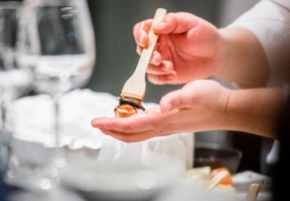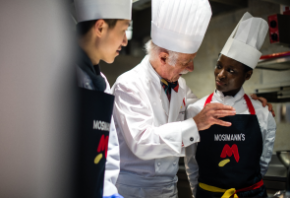- About
- Programs
- Campus Life
- Career Services
- Admissions
- News & Events
- Alumni
25+ Types of Noodles: A Guide to Global Noodle Varieties
Discover 25+ different types of noodles from around the world! Learn about wheat, rice, and specialty noodles, plus how to use them in the best dishes.
Key Takeaways
- There are hundreds of different types of noodles in the world that vary based on their ingredients, shape, thickness, and texture.
- Some of the most common noodle types include spaghetti, udon, soba, ramen, rice vermicelli, ho fun, and pad Thai noodles.
- Noodles are incredibly versatile—paired with the right sauce, broth, or cooking method, they can create endless flavorful dishes.
There's something universally comforting about noodles. They can be dressed up with rich sauces and carefully selected garnishes or kept simple with a light broth and fresh herbs.
Perhaps the best part—though it's hard to choose, given how endlessly delicious they are—is their variety. With so many types to explore, aspiring chefs must understand how to match each noodle to the right dish.
Different Types of Noodles
With hundreds of noodle varieties worldwide, each region has developed its own unique types, shaped by local ingredients, traditions, and cooking methods. From chewy wheat-based ramen in Japan to silky rice noodles in Southeast Asia and hearty egg noodles in Europe, noodles play a central role in countless cuisines.
Each type pairs with specific sauces, broths, and seasonings, creating infinite possibilities. This incredible variety and adaptability make noodles a beloved food—simple in ingredients yet rich in diversity and flavor.
Wheat-Based Noodles
Made from just wheat flour, water, and egg, wheat-based noodles demonstrate how a few basic ingredients can transform into a wide range of textures and flavors in the hands of a skilled chef.
Italian pasta
When it comes to pasta, Italy takes pride in being the best. Hence why our alumni, for example, Ali, a Culinary Arts BA program student, aspired to travel to Italy to master the art of pasta-making.
And there’s plenty to learn—Italian cuisine has hundreds of different types of pasta noodles that range in shape and size.
Spaghetti
Long, slender, cylindrical, and perfect for twirling around a fork, spaghetti is one of the most iconic classic Italian noodles. This type of noodle goes best with rich tomato sauces, creamy Alfredo, or a simple blend of garlic and olive oil.
Fettuccine
Fettuccine pasta is a bit thicker and chewier than spaghetti. It's flat and about 6.5 mm or a quarter-inch wide. It is ideal for serving with cream sauces or meat ragù because the shape allows the sauce to cling well to the noodle surface.
Linguine
Linguine is like spaghetti's flatter cousin. This type of noodle looks like narrow ribbons that pair beautifully with light seafood sauces, particularly clam-based ones, or silky pesto that gently coats each strand.
Tagliatelle
Slightly wider than fettuccine, tagliatelle has a light but firm texture. It's typically served with meat sauces but can also work well with creamy or cheese-based sauces.
Pappardelle
These wide, ribbon-like noodles—often up to three centimeters across—are best for rustic, chunky meat sauces. They're great when paired with Bolognese or slow-cooked beef and wild mushroom ragù.
Angel hair
Delicate and whisper-thin, angel hair pasta cooks quickly and works best with light sauces, such as fresh tomato and basil or a simple drizzle of olive oil and lemon.
Vermicelli
In Italy, the vermicelli noodles are a bit thicker, but elsewhere, the pasta by this name is extremely thin. The classic variety resembles spaghetti but is rounded into shapes and can be the basis for broth-based dishes or served with light oil-based sauces.
Chinese wheat noodles
Chinese wheat noodles, for many, bring to mind bustling street markets and comforting bowls of soup shared around family tables. A few beloved varieties include:
Lo mein and chow mein
Lo mein and chow mein are two dishes that sound similar and are made with the same type of wheat-based Chinese egg noodles but prepared in different ways.
For lo mein, the noodles are boiled, then gently tossed with sauce, staying silky and tender. When preparing chow mein, those same noodles are stir-fried until parts become crispy, adding texture and crunch.
Hand-pulled noodles (Lamian)
Hand-pulled noodles, or lamian, are a true art form. The dough starts as one smooth mass, and through a series of stretching, twisting, and pulling, it transforms into long, even strands without a single cut.
They're typically served in rich, flavorful broths—like the famous Lanzhou beef noodle soup—or stir-fried with savory, spicy sauces.
Knife-cut noodles (Dao Xiao Mian)
These thick, hearty noodles are shaved from a block of dough straight into boiling water, giving them an uneven, rugged shape. Each strand is thick on one side and thin on the other, with ruffled edges that eagerly grab onto sauces and broth.
Japanese wheat noodles
If you've ever watched an anime or a Studio Ghibli film, you've seen some type of Japanese noodles. They're made to be savored slowly, with quiet appreciation—and a good slurp is part of the experience, too.
Some of the most common types of Japanese wheat noodles include:
Udon
These noodles are known for their thick and smooth strands. Traditionally, udon is served in a delicate dashi-based broth and accompanied by green onions, tempura, or slices of meat.
In warmer seasons, it can also be served with a light dipping sauce to make it a more refreshing dish.
Ramen
Ramen noodles are easily recognized by their slight yellow hue and springy texture. They are usually cooked in rich broths and served with toppings like marinated soft-boiled eggs, slices of chashu pork, and nori.
Somen
Somen are some of the most delicate Japanese wheat noodles. These fine, silky strands are typically enjoyed cold, especially during the hot summer months, and are served with a light dipping sauce that enhances their subtle flavor.
Rice-Based Noodles
Rice-based noodles are made from rice flour and water—so they're gluten-free. Many types of noodles fall under this category, but generally, the main ones include the following:
Chinese and Vietnamese rice noodles
In both Chinese and Vietnamese cooking, rice noodles are part of many everyday meals. Two of the most beloved varieties are rice vermicelli and ho fun, both of which appear in light yet full of flavor dishes.
Rice vermicelli (Bun, Mi Fen)
Unlike the Italian pasta from which its name derives, rice vermicelli is much finer, more delicate, and designed for absorbing bright, sharp flavors rather than heavy sauces.
In Vietnamese cuisine, bowls of rice vermicelli are served with grilled pork, fresh herbs, and tangy dipping sauce. They are also often used to fill fresh spring rolls, adding body without heaviness. In Chinese cooking, they are often stir-fried with vegetables, shrimp, or beef.
Ho fun (Wide Rice Noodles)
These flat noodles are typically around 1 to 2 centimeters wide and often used in Cantonese-style beef chow fun, where they're stir-fried with soy sauce, bean sprouts, and tender slices of beef. They can also be served in soups.
Thai and Southeast Asian rice noodles
In Thai and Southeast Asian cuisines, rice noodles are used in some of the region's most iconic dishes. The most celebrated varieties include:
Pad Thai noodles
Pad Thai noodles are medium-width flat rice noodles, slightly opaque when raw but turning glossy and soft after cooking. Their texture is slightly chewy with just a hint of stickiness. These noodles form the base of Thailand's most famous dish, pad Thai.
Kway teow
These noodles are made from steamed sheets of rice flour dough that are folded into blocks and then sliced into approximately 1-centimeter-thick strips. The texture is quite soft and also slightly chewy, with a slippery quality that makes them ideal for high-heat stir-frying.
Buckwheat and Starch-Based Noodles
Wheat and rice noodles tend to be the most familiar, but there's an entire world of other noodle types crafted from buckwheat and starches. These noodles offer completely different textures and flavors. They might not be the star of everyday dishes like the previous two groups, but they're also part of many delicious dishes.
Japanese buckwheat noodles
In Japan, buckwheat noodles are rooted in tradition and are often served chilled in the summer or in warm broths during colder months, reflecting the seasonal balance so central to Japanese cuisine.
Soba noodles
Soba noodles are thin, round noodles that are quite similar in thickness to spaghetti but softer in texture and have a gentle graininess from the buckwheat flour. They can be made with 100% buckwheat or a blend with wheat flour for more elasticity.
One of the most iconic ways to enjoy soba is in zaru soba, where the noodles are served cold on a bamboo mat with a chilled dipping sauce, wasabi, and finely chopped green onions.
Korean starch-based noodles
Korean cuisine also brings a distinct noodle variety to the table, which is made from starches. These noodles are smooth, glossy, and great for stir-fries or festive dishes.
Dangmyeon (Korean glass noodles)
Dangmyeon are long, round noodles made from sweet potato starch. When dry, they appear dull gray, but once cooked, they turn translucent and glossy with a springy, slightly elastic texture—giving them the name of glass noodles.
They're thicker than Italian vermicelli but still light. The most well-known dish featuring these noodles is japchae—a celebratory Korean stir-fry made with dangmyeon noodles, sesame oil, soy sauce, garlic, sautéed vegetables, and thinly sliced beef.
Specialty and Alternative Noodles
There's also a growing group of specialty and alternative noodles that break away from the familiar, offering options for those seeking something lighter, more nutrient-dense, or simply different.
Gluten-free and low-carb noodles
For some people, gluten-free and low-carb options are preferences; for others, necessities. Whether for health reasons or dietary choices, these noodles make it possible to enjoy comforting noodle dishes without compromise.
Shirataki (Konjac) noodles
Shirataki noodles, often called "miracle noodles," are made from the fiber of the konjac root. They're translucent, thin, and almost gelatinous in texture, with a bouncy chew. What makes them special is their extremely low calorie and carb content.
Kelp noodles
Kelp noodles are made from mineral-rich seaweed and have a unique texture: crisp and slightly crunchy when raw but softer after soaking or heating. They're naturally gluten-free and extremely low in calories—an excellent addition to cold salads or dishes with vegetables and seafood.
Legume-based noodles (lentil, chickpea, edamame)
Legume-based noodles are made from flours of lentils, chickpeas, or edamame. Because of their base, they have a higher protein and fiber content than many of the other traditional noodles.
They are denser but still mimic the familiar feel of pasta with the addition of a subtle earthiness to their taste that pairs nicely with both Mediterranean and Asian-inspired flavors.
Other regional noodles
As demonstrated throughout, noodles are regionally specific. Although they are not as well-known worldwide, these noodles have long been cherished staples in their native countries.
Spaetzle (German egg noodles)
Spaetzle are noodles made from a loose batter that is pressed through a special tool known as a spaetzle slide and dropped directly into boiling water. Once the noodles are cooked, they resemble tiny dumplings and are served as a side for meat dishes with sauce.
How to Choose the Right Type of Noodles for Your Dish
Noodles differ based on their shape, thickness, or texture. All these things affect how the noodles hold the sauce and absorb flavor.
Therefore, before you cook a dish, it's important to consider the style of the meal you're making and choose a noodle that will complement it.
- Thin noodles work best for light broths, delicate sauces, and cold salads.
- Medium noodles work well with light to medium-thick sauces, stir-fries, and soups.
- Thick or chewy noodles can handle rich sauces, hearty soups, or meaty stir-fries as they can soak in flavors without becoming mushy.
Another way you can know which noodles to use is by focusing on the sauce and cooking methods you're using, such as:
- Oil-based sauces pair best with thin noodles.
- Creamy or heavy sauces work with thick noodles.
- Broths and soups need springy, firm noodles that can sit in hot liquid without breaking down or turning soggy.
- Stir-fries go best with chewy, sturdy noodles that absorb flavor while staying intact.
Learn the Secrets of Perfect Noodles
With hundreds of types of noodles to choose from and just as many ways to prepare them, the important part is knowing how to pair the right noodle with the right technique, sauce, or broth—once you know how to do that, the combinations are nothing short of extraordinary.
At Culinary Arts Academy Switzerland, we help you build that knowledge and much more. Through our BA program in Culinary Arts or aour one-year Diploma in Culinary Arts, you'll learn the foundations of cooking and the business behind it but also explore specialties, like pasta-making, through internships, hands-on work, and demonstrations.
We believe in learning from the very best, and that's why we invite chefs like Chef Robert Ciborowski, Executive Chef from Walt Disney World Swan & Dolphin Resort, to lead special pasta-making demonstration classes for our Term 2 Culinary students.
Your culinary future is like pasta—as long as you have the right foundation and are creative, then you can twist it into something extraordinary.
Frequently Asked Questions
What is the oldest type of noodle ever discovered?
The oldest known noodles, which were discovered in China over 4000 years ago, were made from millet, an indigenous grain to that region.
How do chefs test the doneness of noodles without tasting them?
Most chefs gently squeeze a noodle or slice a noodle to check whether it's cooked through. The noodles should feel firm but not hard and tender but not mushy.
Interested in studying at CAAS? Download our brochure to learn about our programs!
































